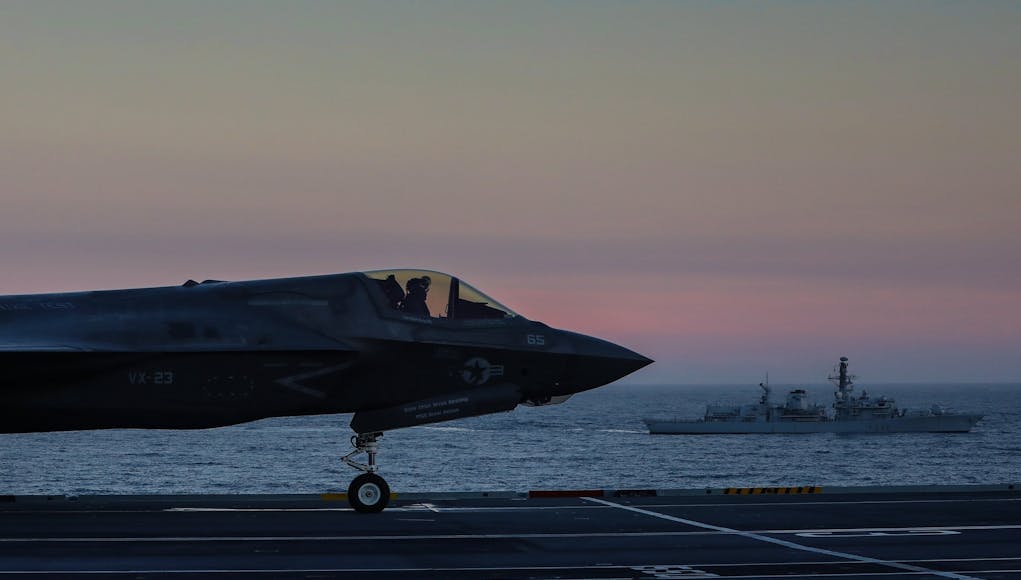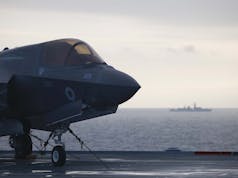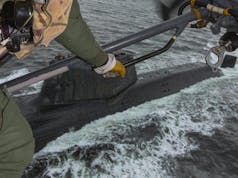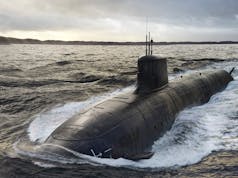The Shipborne Rolling Vertical Landing (SRVL) is a British endeavour—a capability at least a decade in the making—that will allow pilots to return to ship with more stores.
British test pilot Peter Wilson made history recently when he conducted the first ever shipborne rolling vertical landing. The Royal Navy say that previously the jets have conducted only vertical landings, hovering by the side of the ship before moving sideways over the deck and gently lowering down.
There’s a video of the first SRVL on HMS Queen Elizabeth here.
A rolling landing however requires the jet to make a more conventional landing approach, approaching the ship from behind at speed, before using thrust from its nozzle and lift created by air over the wings to touch down and gently come to a stop.

It is a process designed to land jump-jet aircraft that uses both the vertical thrust from the jet engine and lift from the wings, thus maximising the payload an aircraft can return with and stopping the financial waste that comes with dropping expensive weaponry in the sea in order to land vertically.
Since June, The F-35 Patuxent River Integrated Test Force (ITF) team has focused on live flying workups refreshing their skills on day and night field carrier landing practices, ski jump takeoffs and vertical landings in preparation for the arrival of HMS Queen Elizabeth.
The team also conducted rolling vertical landings in preparation for another unique British development, according to a recent release.
“[Rolling vertical landings] are an important phase of the workups because another unique aspect of going to the Queen Elizabeth Class carrier is that we will be conducting experimental testing of a novel recovery landing technique—the Shipborne Rolling Vertical Landing” said Royal Air Force Sq. Ldr. Andy Edgell, FOCFT (FW) lead test pilot at the Pax River ITF.
“SRVL tests are truly experimental. It involves landing a fast jet onto an aircraft carrier with forward relative speed but without the braking assistance typically provided by an arresting gear and hook. It’s going to be a really rewarding moment for British aviation to watch that procedure actually take place.”
It can also reduce the level of wear on the lift engines and extend their operational life. Similarly, it can reduce the amount of wear upon the deck surface of a carrier caused by the downward jet exhaust from vertical landings.














What a wonderful British invention.
Imagine the capabilities the Royal Navy could have if we had the same budget as the American Navy, head and shoulders above the rest we would stand.
(that we do already in terms of quality).
Rule Britannia!
Along with angled decks, VTO, ski ramps, etc
Geoff wrote:
“Along with angled decks, VTO, ski ramps, etc”
The British have been one of the most inventive people in the world when it comes to ships at sea and something that we should be really proud of. (Thinks of the Plimsoll line)
Regards aircraft at sea didn’t the RN look at a hook system to pick up hovering harriers from small ships. Now that would have really pushed the capabilities of the RN to a new level.
Yup i was right:
https://www.flightglobal.com/FlightPDFArchive/1983/1983%20-%201517.PDF
That is possibly the craziest idea in naval aviation I’ve ever seen. Imagine being in a Soviet MPA or bomber on patrol. You see a frigate and go to have a look, when suddenly it throws a Harrier at you. You’d be going straight to brown alert
Remember catapult launched Hurricanes over the Atlantic.
Same problem , its a one way journey
Careful Jack.
You may “Offend” with patriotism like that.
Bravo good on you….
I wish we had far more patriotism like you and Jack around this country.
Bravo indeed
Errr…no need to imagine – we’d have the same capability as the US Navy (so not quite ‘head and shoulders above the rest’, as we’d be the same as one).
Interesting article. When you think about it it would make sense for rolling vertical landings to be the normal method of recovering the F35. It’s hard to think of the advantages of vertical landings if this is an option.
The main issue is safety and risk.
Imagine a wet deck, crowded with other fuelled and armed aircraft, in poor visibility, in a rough sea state. They have to be sure that the landing aircraft can safely and accurately stop within the space allowed, and has the option to “bolt” if the brakes should fail.
Not to say it can’t work, but its novel, and risk managers hate novelty. Which is why they are starting simple with an unladen aircraft, on a dry and largely empty deck, on a calm bright day, and building up from there.
What would it involve to fit traps as a fail safe? Should imagine would not make sense in terms of benefit for cost but would be nice to know Also if a SRVL fails then how easy is it to switch to a takeoff for another attempted landing? There must be some red lines there?
if we did fit traps as a backup, surely that’d mean n e2-d would work off the qe??
given its length id be slightly surprised if it couldn’t take off from her…. i have vaguely wondered whether they would work without them too, but have never been able to find a definitive answer as to why they wont work without cats…..
i mean hell, back in the 80’s or whenever it was the us managed to park a c130 on a carrier ffs!
even if they needed refueling after launch, surely the benefits they offer over the merlin crowsnest would be worth it? would love to get an answer from someone….
Arrester wires involve a huge amount of gubbins under the deck – not something that can be easily retro fitted, if at all.
The QEC do have an extra deck between the hangar and flight deck to incorporate the equipment necessary for CATOBAR, but it would be bloody expensive. Back when they considered converting PoW to CATOBAR they found it would add an extra £1-2bn, nearly doubling the cost of the ship, because they’d have to cut open the flight deck and make structural modifications.
(Chris H) Callum- In fairness I don’t think the £2 Bn was for the actual work it was because back in 2010 EMCATS (the British system) while better (then) than the US EMALS system still had a way to go on development. The Americans couldn’t even give a price for EMALS let alone a delivery date and a guarantee it would work. So an estimate was made
We read / hear about how the Americans offered to give us EMALS but I can find no confirmation of that story. In any case no matter the purchase costs they still don’t work on the Ford Class 8 years and $ Bns of development costs later. The Yanks will make it work as they always do and we have to respect that ‘never say die’ attitude and ability to throw huge amounts of money at a problem. But we simply cannot afford that way of doing things.
So the vast majority of the costs were allocated to the actual electro-magnetic catapult system not the conversion work. The carriers are, in any case, passively engineered for that conversion.
I think that as we develop how we use the F-35B we will show we made the right decision in 2010 and have a new and better way to deploy 5th Gen carrier strike capability.
What would it cost to fit trap wires as a fail safe? Could the benefit be justified against the cost? Also if an emergency takeoff is required for a second attempt, there must be some Red Lines as to last point at which manoeuvre can be initiated. Would the protocols be similar to those used by fixed wing conventional landings/take-offs?
Traps would mean a hook on the airframe, these are normally at the tail but the F35b the nozzle is facing down and could direct hot gases onto the hook. The theirs the deck wires the nozzle heat could also damage these. one option is to fit an arrester barrier, the US carriers have them and are used in emergencies.
A safety trap would be a good idea, unfortunately the F35B isn’t equipped with a hook!
A few qualified observers have previously noted the issues with RVL’s on a wet pitching deck.
It means you would have to touch down closer the ships center to avoid the pitching stern, with the subsequent worry about stopping in time.
A bolter would be a very interesting white knuckle ride in that circumstance, that’s for sure!
That said, it should mean that RVL’s can be employed at least 80% of the time …… unless of course we find ourselves back in the mountainous seas of North Atlantic as Cold War 2 hots up gents!
if we did fit traps as a backup, surely that’d mean n e2-d would work off the qe??
given its length id be slightly surprised if it couldn’t take off from her…. i have vaguely wondered whether they would work without them too, but have never been able to find a definitive answer as to why they wont work without cats…..
i mean hell, back in the 80’s or whenever it was the us managed to park a c130 on a carrier ffs!
Yeah, I’ve also posted similar in the past. Cats, yes expensive but traps would not have cost the earth and would give us options, look at the direct the US is going with unmanned refuelling there unlikely to be a STOVL tanker. The C130 landing was impressive and Forrestal was similar in size to the QE.
fast forward to 1 minute in.
https://www.youtube.com/watch?v=ar-poc38C84
Doesn’t the E2D use cats for taekoff?
it does on us carriers….. i was more wondering whether ir could take off from the qe without them
It’s an interesting discussion but there’s taking off and there’s taking off. Not all takeoffs are the same.
I assume that for acceptable operational efficiency an E2D needs to take off with a heavy fuel load so that it can climb to the required altitude and then stay on station for an acceptable period of time before it’s necessary to relieve the on-station aircraft. Even if an E2D could take off without cat the real question must be could it take off with an acceptable heavy fuel load to make it worthwhile?
Geoff – surely the Failsafe in that case is a Vertical landing no ? .
Absolutely Paul but there will be some 50/50 calls that the pilot may get wrong.
I have wondered about this as well, if the say the lift fan door gets stuck and they’re in the middle of the Atlantic for example, what do they do. One answer is to get mid air refuelled and land on a conventional runway. However, an available tanker aircraft may not always be available and ditching a £100+ jet in the sea is not a brilliant solution. Therefore I’m very surprised that the QE/Pow aren’t fitted with a crash barrier just in case. It would also make sense for a conventional aircraft emergency to land on the QE if it had a barrier as there’s plenty of space.
There more probability of something going wrong with an F35B. The number of doors that need to open to perform the VL, any one of which could fail even with minor battle damage. Popup arrestor barrier is a obvious solution and probably cost less than 1 f35B. I know there other arrestor solutions like a foam which slows the aircraft but clearing that from the deck would be a nightmare
Geoff – in that case surely the Failsafe would be a Vertical Landing no ?.
Risk managers love novelty, it is after all the point of the job. Thinking about and assess the likelyhood of that which has not yet happened, how it will impact and put in place mitigation’s from stop it being a problem.
Risk managers just love something that lets them start thinking what if…….
test
Hello.
More astonished they dump weoponary in the sea.
Tremendous kit coming together only the yanks can better .. That carrier will become some power serious power
Fantastic .
I still think an idea worth exploring for the RN is a modernized “Doolittle Raid” Hail Mary move for an emergency. In which the QE launches Typhoons (I understand from board member that this is theoretically possible) in an Alpha Strike with F35s clearing the way ahead of the strike wave. The Typhoons could launch everything they have and then peel off to recover at a land base (perhaps tanked along the way). Could you imagine the confusion of an enemy expecting one thing and receiving quite another? Oh well… Tinfoil idea of the day!
Cheers!
Love this idea. If both carriers deployed with hanger and deck full, what would that be, close to one hundred aircraft? If The baltics or Norway were invaded, it’s not beyond the realm of possible.
If the Typhoons can recover at a land base, they could have taken off from it in the first place. With bigger payloads.
Looks like the RCN is putting off decision again…
https://www.janes.com/article/83808/canadian-frigate-delayed-again
Cheers!
Hopefully it’s to ensure they make the Right choice!
?
(Chris H) I am surprised the article didn’t mention the ‘Bedford Array’ which was developed alongside SRVL by Qinetiq here in the UK and tested on Invincible and the French carrier Charles de Gaulle. Another superb piece of British ingenuity. Even more surprised it is being fitted to PoW ‘as a trial’ but not QE until refit while the US Navy are already funded for its fitment on carriers. It facilitates safer carrier landings in rougher weather by giving more accurate placement on a heaving deck.
The US Navy are using the SRVL approach vectors of ‘Descent – Plateau – Descent’ for the F-35C for CATOBAR carrier recovery with or without ‘Bedford Array’. From IHS Jane’s Defence Weekly in March 2014:
“The US Navy (USN) has seen benefits in aspects of the UK’s Shipborne Rolling Vertical Landing (SRVL) technique for recovering the Lockheed Martin F-35C Lightning II Joint Strike Fighter on to the deck of its aircraft carriers […] Work being undertaken at BAE Systems’ simulator facility in Warton to test the SRVL technique for landing the UK’s short take-off and vertical landing (STOVL) F-35B aboard the Queen Elizabeth (QE)-class aircraft carriers is being closely studied by the USN and a number of benefits have been identified, the company said. “Joint research efforts on both sides of the Atlantic have developed enhanced aircraft flight controls and displays which are applicable to both the F-35C and the F-35 SRVL recovery to the aircraft carrier, albeit separated by some 70 kt approach airspeed”
According to James Denham from the Aeromechanics division at the US Naval Air Systems Command (NAVAIR):
“Simulations show that adopting aspects of the SRVL manoeuvre for F-35C conventional landings result in more accurate landings, less bolters and reduced pilot training. The technique works by having the pilot acquire the Bedford Array deck lighting system, which was invented by a former UK Harrier pilot. The array features a series of evenly spaced lights that run the length of the flight deck centerline, only one of which flashes at any given time. The illuminated light changes in sync with the pitching of the ship, enabling the pilot to focus on one point on the deck regardless of the relative movement of the ship”
(Chris H) – I am surprised the article did not mention the equally impressive and British invention called ‘Bedford Array’ (BA). Both SRVL and the BA simulations at Warton have been studied by the US Navy for use by the F-35C and are already funded for fitting BAs to carriers. The ‘C’ will use the ‘Descent – Plateau – Descent’ approach of SRVL but will use BA for final touchdown.
Even more surprised we are not fitting it to QE and only on a ‘technology demonstrator’ basis on PoW. Talk about missing the proverbial … again.
I was surprised how slowly the F35b appeared to approach for the srvl . I’m guessing that the speed will need to be ramped up as the bring back weight is increased.
I’m no airframe engineer but wouldn’t putting a hook on the f35b require a whole host of re-engineering in that part of the airframe to be able to manage the forces involved in stopping a jet at any kind of speed?
(Chris H) – sorry about the duplication above – I posted and it didn’t show as normal so I did a shorter one … and that didn’t show either … My bad .. sorry..
Couple of points:
the RN have a history of innovation and I believe RVL is the latest, if you have watched the video the you will probably be thinking what is all the fuss about.
Secondly, each QEC cant accommadate 70+ aircraft and given this is a substantial % of the UK’s available maritime combat aircraft population, I am not sure how many full decks these aircraft will be landing on to.
Thirdly, Risk managers manage risk, they do not try to eliminate risk they accept risk within certain parameters, that is different and worth acknowledging. I suspect the risk threshold for this type of thing is acceptable.
Lastly and more of a personal view, the B variant has given the UK a large amount of flexibility in many respects that a none VTOL aircraft simply could not offer. I truly believe this innovation born out of necessity is truly ground breaking and ultimately will prove a step change for our future.
RVL has been around for about 50 years. It’s SVRL which is sort of new but not really.
RIP…
https://www.zerohedge.com/news/2018-10-16/american-pilot-killed-during-clear-sky-2018-joint-exercises-ukraine
We need to remember “Freedom isn’t free”…
See we all had the same problem when the the page wasn’t accepting comments hence double posts all round!!
Planning for the new La Royale carrier.
http://www.navyrecognition.com/index.php/news/naval-exhibitions/2018/euronaval-2018/6564-france-started-emals-talks-with-u-s-for-its-future-pa-ng-aircraft-carrier.html
Cheers!
No point in messing around with Traps. STOVL/VTOLis the future, next generation engines will give even greater bring back weights where a conventional landing relying on aerodynamic lift has a fixed amount based on the speed of the aircraft. The F35C already lands at over 180 mph about the same speed a TGV cruises at.
If we could invest in a proper fixed wing VTOL capable AWACS platform through either an unmanned drone or V22 style platform then QE could have almost all the capability of a CTOL style carrier at a fraction of the cost and with much greater flexibility and resilience.
CTOL/CATOBAR carriers are a terrible technology made to work by dedicated people and massive budgets.
Fantastic news and brilliant footage.
The team made it all look so easy its going to be a lot easier from now on. I hope they get well deserved BEM’s!
Couple this great news with the USMC checking everything for size, brilliant.
I understood barricades were going to be fitted. Maybe wrong I hope not?
I’ve also heard the F18 can launch ’empty-ish’ from the ramp? If so that will be amazing for cross deck emergency use.
It would be interesting to know how much extra weight this process actually allows. It sounds good in theory but what does the reality mean by weapon and fuel loads etc.
YAK 38 did SRVL in 1980s
Harrier did SRVL in 2007
V22 Osprey did SRVL in 2015
F35B did SRVL in 2018
Sorry but Peter Wilson was not the first to do an SRVL, unless you add “on the QE carrier” at the end of that statement